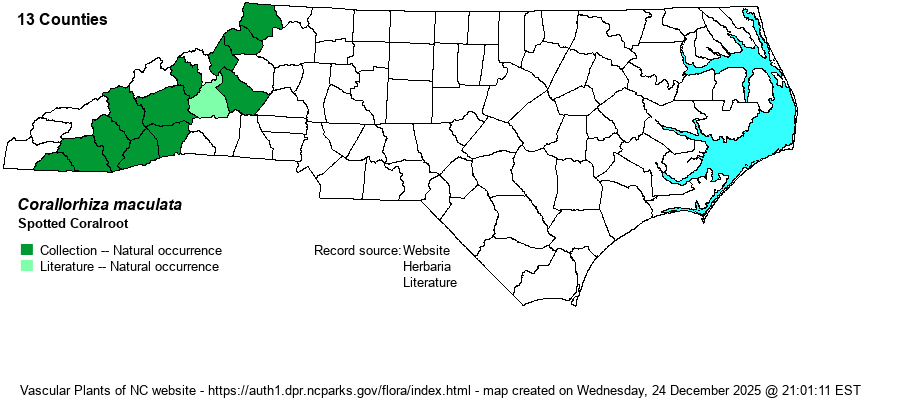| Author | (Rafinesque) Rafinesque | |
| Distribution | Recorded over nearly all of the Mountains, with only a few counties lacking records. However, alarmingly, data collected by the NC NHP indicate recent records for only three counties, mostly just a single flowering stem! Not present downstate. Photo records on iNaturalist -- the only ones ever posted from NC (!) -- are for Clay County in 2021, Buncombe County in 2023, and Ashe County in 2024, to verify that at least a few plants still survive in the state.
This is possibly the widest ranging orchid in North America, occurring across Canada and most of the Northern and Western states, including WA, OR, and CA. In the East it ranges south to NJ, PA, and OH, southward only in the Appalachians to extreme northern GA. | |
| Abundance | Strongly declining in recent decades. Formerly perhaps infrequent to even locally common, but presently it is very rare and in danger of extirpation. Most experienced biologists have never seen it in NC, but thankfully it can be seen much easier in NY, CA, and many other places well away from the state. Though formerly not listed by the NC NHP, in the last few years it has been tracked by them as a Significantly Rare species. (The brackets on the SR-P rank below indicate that the NHP status is for the variety; as this is the only variety in NC, the editors have chosen not to re-populate a variety account.) It probably deserves at least State Threatened status, within the next decade. | |
| Habitat | This species occurs in moist forests, in deep decaying humus (as it is saprophytic), generally near shaded stream banks or in other moist forests, often in mixed hardwood-conifer forests. It can grow in somewhat more upland forests, such as Northern Hardwood Forests. | |
| Phenology | Blooms in July and August, and fruits in August and September. | |
| Identification | A handful of orchids are saprophytic -- getting nutrients from dead or decaying organic matter -- and therefore have no chlorophyll; thus, no parts of the plants are green. This species grows to 1-2 feet tall, with a bronze or golden-brown stem, often with a purplish tint. The top quarter of the stem consists of the inflorescence, with 10-20 scattered flowers. Each flower is about 1 inch long and about 1/2-2/3 inch across; they are roughly the same golden-bronze color of the stem, except for a white lip with purple spots. Because this and other saprophytic plants lack leaves, they can be quite hard to spot in a shady forest, unless a colony is found; single individuals can be easily passed over! (It can occur in dense stands.) Sadly, for whatever reason(s), this striking plant, quite large for a Corallorhiza, has greatly declined in NC since the days of RAB (1968). The other two species in the genus are much smaller; C. wisteriana blooms and fruits only in spring (and is underground by late spring), whereas C. odontorhiza blooms in very late summer and fall and is quite small -- in fact, rather tiny for an orchid. | |
| Taxonomic Comments | None, other than the species has several varieties; the one occurring in NC is the nominate one -- C. maculata var. maculata.
| |
| Other Common Name(s) | Summer Coralroot | |
| State Rank | S1 | |
| Global Rank | G5 | |
| State Status | [SR-P] | |
| US Status | | |
| USACE-agcp | UPL link |
| USACE-emp | FACU link |

